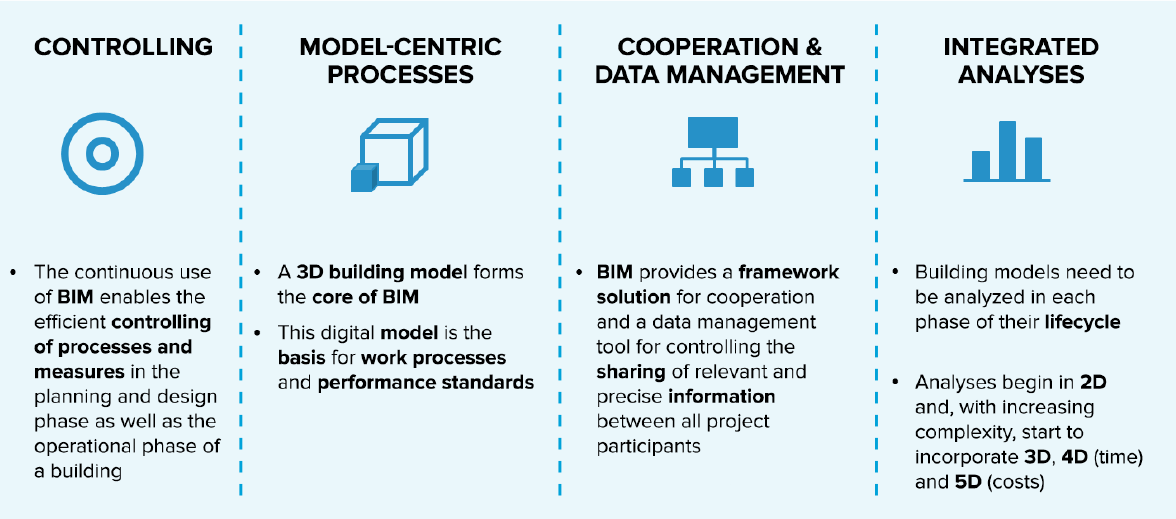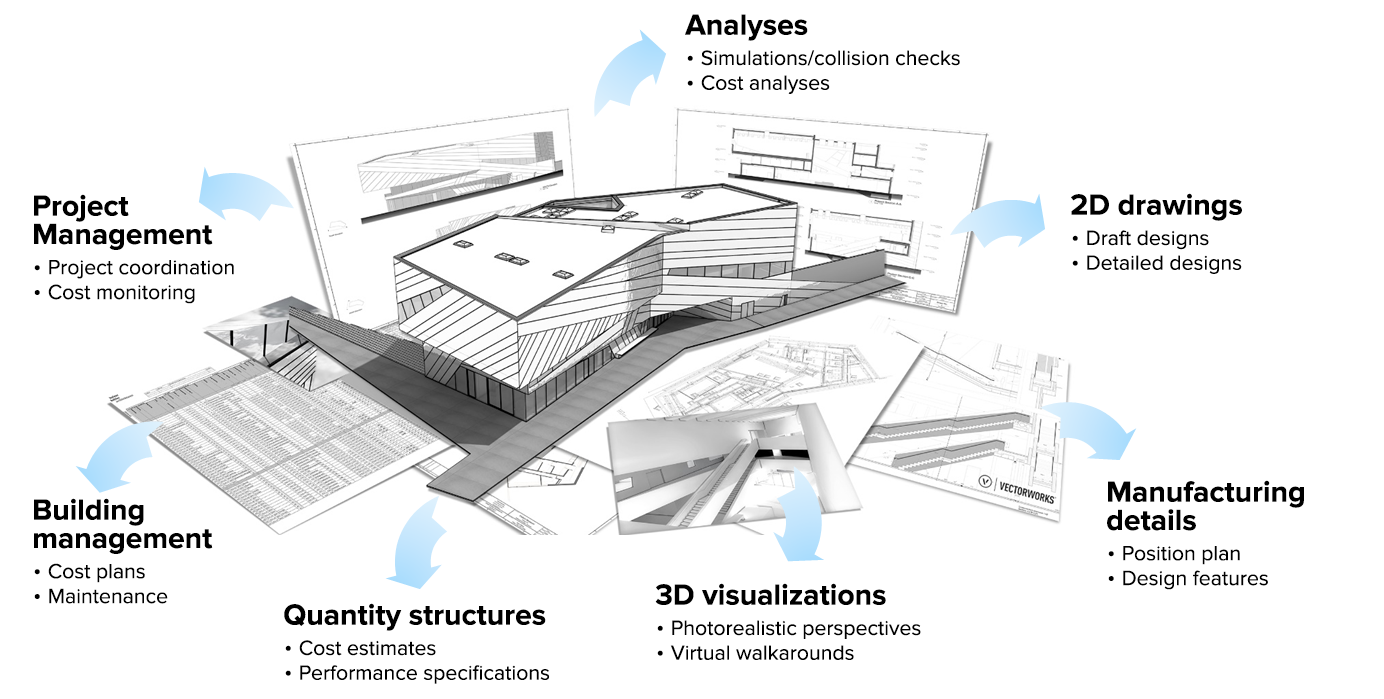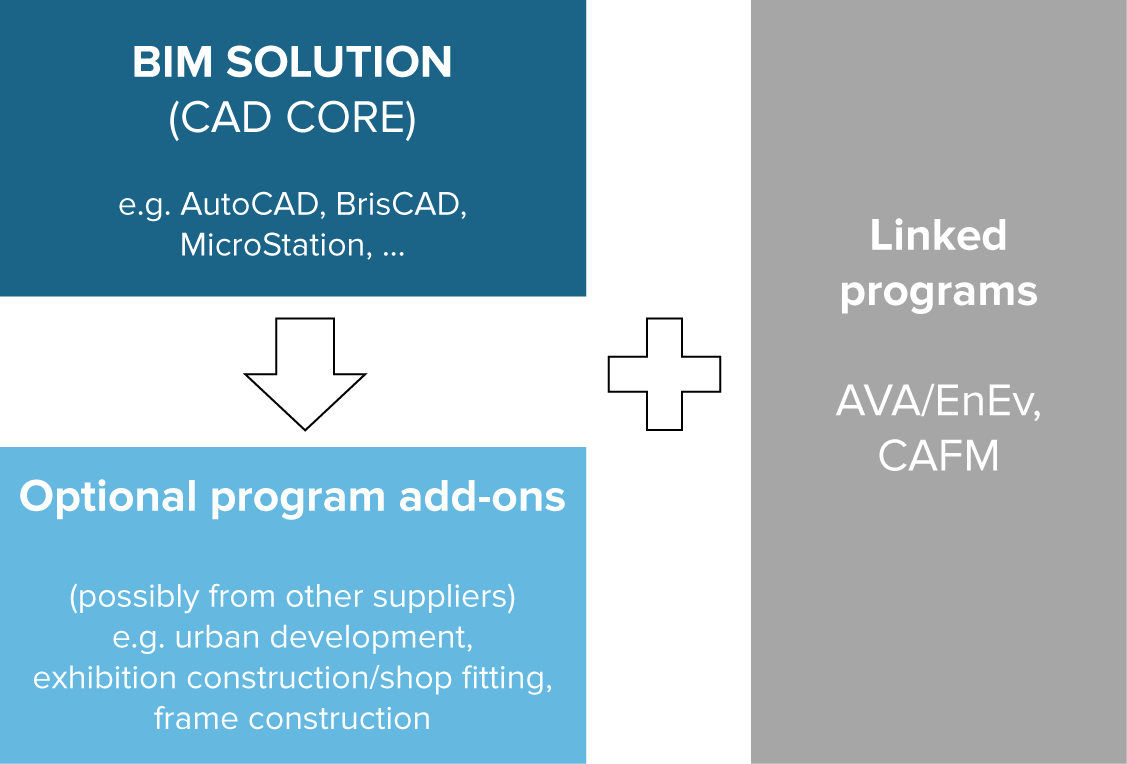Digitizing Construction with Building Information Modeling
Major construction projects in Germany end all too often in a planning disaster with huge budget and build-time overruns. We have seen that in projects like the Elbe Philharmonic Hall in Hamburg and Berlin Airport. Building Information Modeling (BIM) is a method that promises greater planning security and easier project control. It is for this reason that the government has drawn up a phased plan for the introduction of BIM in Germany.
Federal Transport Minister Alexander Dobrindt has defined it as a national objective to introduce BIM as the planning standard for major infrastructure projects by the year 2020.1 In January 2017, Dobrindt also presented a “Construction 4.0 master plan” as an extension of the phased plan.2
BIM can be used not only to model the planning and construction phase, but to map out the entire lifecycle of a building. The use of BIM could be of interest to residential real estate companies during a building’s operational phase in particular. After all, if you consider the entire lifecycle of a building, the planning and construction phases account for just 2-3% of the building’s useful life on average – some 15% of total costs are incurred in these two phases. But the remaining costs come mainly in the operational phase and it is here that BIM can optimize processes and cut costs.3 But what exactly is BIM?
BIM – What exactly does it involve?
BIM is first and foremost a cooperative method of working which is based on a digital model (a smart 3D model). The aim is to capture all of the processes and information concerning a building in the early planning and design phases and connect them together in a way that is transparent for everyone involved in the project. What this does is simplify the process of modifying the plans in later project phases and it optimizes time schedules, construction costs and project risks.

Figure 1: Key elements of Building Information Modeling
Basically, BIM can be split into four key elements (Figure 1). The digital model of the building serves as a working basis for all of the project participants and brings together all relevant information on the building. The smart 3D models consist of more than just lines, surfaces and volumes – they also include objects specific to the building (e.g. walls, doors and windows). The structural elements are recorded in the model along with their specific properties such as material, manufacturer, lifetime, maintenance intervals, etc.
Throughout the entire process of planning and constructing the building, the model is continuously filled with data, enhanced and kept up to date. Using the BIM model enables more efficient controlling of all processes and measures taken within the construction project. The digital model of the building allows all project participants access to the data, which they can then share and modify. This guarantees that everyone is always on the same page as the project progresses and facilitates better cooperation. The digital model can be used to conduct a diverse range of analyses (e.g. cost analyses, simulations, etc.), which permit detailed insights into quantities, costs, timings, and so on. Alongside the possibility of producing integrated analyses with the help of the digital building model, other relevant documents can also be generated from within the model. As shown in Figure 2, these range from two-dimensional drawings (e.g. draft or detailed designs) to three-dimensional design visualizations and virtual building walkthroughs to quantity structures for performance specifications.

Figure 2: Functions of the digital building model / © Grafik Vectorworks Inc.
The creation of smart, three-dimensional building models with information on components linked in simplifies the work of architects and technical planners. Advantages arise from the use of BIM above all in the planning and construction phase in the first instance. Planning quality can be significantly improved through simulations and collision checks. This enables subsequent changes and additions to be minimized along with interface risks, and also permits the early identification of design errors. Costs can be optimized thanks to the model-based analyses and cost simulations and, in fact, costs are also reduced down the line because quantities and costs are precisely calculated. Time, too, can be saved with the use of BIM, given that it facilitates the faster implementation of design alterations. Not only that, but the level of transparency and availability of data means that decisions can be made quicker.
At first glances, it might appear that BIM is a method primarily aimed at the design and construction phase of buildings and that most of its benefits will be felt there. But BIM is not just for these two phases – it spans the entire lifecycle of a building. The digital model can be very useful in the operational and end-of-life phases of a building, making the use of BIM there well worthwhile.
BIM – How can it be used in the residential real estate sector?
At the end of the building’s construction phase, the construction firm hands over an as-built model of the building to the client. The corresponding digital model is an exact virtual copy of the building as it stands in reality, and contains all relevant information. The handover of the digital model, containing all of the building’s data, at the point of transition from the construction to the operational phase offers the big advantage that it prevents any knowledge from being lost in the process. The fact that about 50% of the costs of subsequently introducing a CAFM (computer-aided facility management) system are incurred in the course of capturing and processing information on the building itself and its contents serves to make this all the more apparent. As much as 10 – 30% of this data is generated during the design phase.4 When the conventional method of planning and design is applied without the use of BIM, such data is not recorded in any usable way. Utilizing BIM therefore presents many opportunities for the residential real estate sector to optimize the management of buildings on the basis of the digital model.

Figure 3: Various program components can be linked in to the BIM model
CAFM systems are used to support the facility management team in the operation of a property. In order to ensure the operational capability of a CAFM system, there needs to be a standardized, well structured and comprehensive database of alphanumeric and graphical data plus relevant documents in place. And the CAFM software needs to be connected to the BIM model in order to make the building data stored in the digital model usable for a residential real estate company. In this context, the BIM solution (Figure 3), which is inherently based on CAD (computer-aided design) software, forms the basis for other optional programs with (industry) specific functionality to be added. The bulk of the data that requires processing in facility management is alphanumeric (e.g. lists of rooms and spaces, lists of doors, lists of technical systems and structural components). When this data is taken out of the digital BIM model and transferred to a CAFM system, the data basis that results enables facility management tasks such as maintenance planning, fault management, cleaning management, etc. to be completed more effectively. The graphical model data itself is of secondary importance. In a facility management context it can be used to manage spaces (layout planning, move and relocation management, etc.). Besides the alphanumeric and graphical data contained in the digital building model, documents produced in the course of the construction project can be used during building operations.5 The existing digital model can also be taken as the basis for modernization, conversion or demolition measures – for precise planning and design and for the calculation of quantities. Positive effects in the management phase of a given property are achieved in the long term assuming that the BIM data model is regularly updated through sensors recording new data. In that case, you would always have access to the latest condition data on all technical facilities relevant to maintenance and traffic safety.6 Cutting-edge technology could also be applied here. Drones, for example, could be used in facility management to measure energy loss and document small cracks in the building envelope.7 It must be said, however, that these potential uses of BIM in facility management are not reflected in practice in Germany today.
Conclusion
The outlined potential for the use of BIM throughout a building’s entire lifecycle is not yet realized in Germany to any great extent. BIM is most commonly used here in the design and construction phase of buildings. Internationally speaking, BIM is much more widely used in some countries, being regularly applied in the UK, USA and Scandinavia, for example. Since April 2016 the digital BIM method is in fact a mandatory requirement on public sector construction projects in the UK.8 Facility management in the context of BIM is not yet established in Germany. Technologically, facility management can already be included in BIM projects. There are international data standards such as IFC (Industry Foundation Classes) and the COBie standard (Construction Operations Building Information Exchange) which enable data sharing in the facility management context. So why is it that BIM is not yet being applied in connection with facility management in Germany? The answer to this question is none too clear. What is certain is that a lot more needs to be done to inform the relevant parties in Germany about what BIM can do. Added to that, particularly in the facility management context, there is a lack of German reference projects to demonstrate the added value that BIM offers and to prove that it works.9 With the BIM method not really having established itself among building designers yet, it doesn’t have much of a presence in the facility management sphere. This is more of a secondary effect and the technology’s presence can be expected to increase as BIM spreads generally and becomes more widely used. As described above, the first steps in this direction have already been taken by the government with its phased plan for the introduction of BIM in Germany and the Construction 4.0 master plan. The technical and theoretical basis for the use of BIM is in place. It is now down to industry players themselves to start putting it into practice. So what are we waiting for?
Contact
Do you have questions regarding this topic? Please contact:
-
 Martin Hümpfner
Martin Hümpfner-
email hidden; JavaScript is required
-
email hidden; JavaScript is required
1 Cf. BMVI (2015), o. S.
2 Cf. Beuthan (2017), o. S.
3 Cf. o.V. (2014), o. S.
4 Cf. o.V. (2014), o. S.
5 Cf. Bender/Schlundt (2016), o. S.
6 Cf. Bogenstätter (2016), S. 8.
7 Cf. Beuthan (2017), o. S.
8 Cf. Beuthan (2017), o. S.
9 Cf. Bender/Schlundt (2016), o. S.